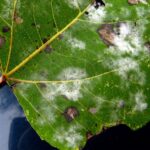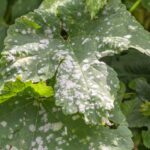Powdery Mildew
Powdery mildew is a common fungal disease that affects a wide range of plants, including ornamentals, vegetables, and fruit trees. The disease is caused by several species of fungi, most commonly Erysiphales, which are obligate plant pathogens.
Symptoms of powdery mildew typically appear as a white or grayish powder on the leaves, stems, and flowers of infected plants. The powder is composed of fungal spores and mycelium, which can be easily spread by wind or splashing water. As the disease progresses, infected leaves may turn yellow, curl, and eventually drop from the plant.
Powdery mildew can thrive in a wide range of environmental conditions, but is most commonly found in warm and humid environments. The fungus can overwinter on plant debris, and new infections can occur when spores are dispersed by wind, rain, or human activity. Plants that are stressed by poor growing conditions, such as drought, poor nutrition, or damage, are particularly susceptible to powdery mildew.
Control of powdery mildew can be achieved through a combination of cultural, biological, and chemical measures. Cultural practices such as pruning, watering, and fertilizing can improve the overall health of plants and reduce their susceptibility to disease. Biological control agents such as fungi, bacteria, and predators can also be used to manage powdery mildew, particularly in organic or sustainable agriculture systems. Chemical control is also an option, and fungicides can be applied to prevent or reduce the severity of powdery mildew infections.
Prevention is key to managing powdery mildew. Maintaining good growing conditions, including proper watering and fertilization, can help plants resist infection. Regular monitoring and early detection can also help prevent the spread of the disease. Infected plant material should be removed and destroyed, and infected areas should be sanitized to prevent the spread of the disease.





